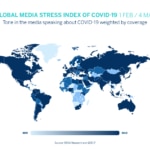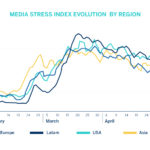A BBVA Research study leverages big data technology to monitor worldwide media treatment of COVID-19. Analyzing more than 80,000 online news publications in more than 100 languages, the study concludes that both the extent of news coverage and its sentiment provides valuable information about the pandemic's development and the degree to which it impacts the economy and politics. Furthermore, a correlation between increased number of infections and ‘media stress’ has been observed.

In producing the ‘Media Stress Index,’ BBVA Research looked at two parameters — the amount of news generated and the sentiment or tone of the news — in order to measure COVID-19-induced media stress (where media stress is defined as an increased quantity of news and/or increased negativity). To this end, the study factored in all online news items in media outlets worldwide (in more than 170 countries) that discussed the coronavirus and analyzes the semantics of each article identified.
The BBVA Research index shows a clear correlation between increased media stress and numbers of new COVID-19 cases. The media's overall coverage and sense of dismay has increased as the pandemic has spread globally: in countries where the epidemic has hit hardest, there is more coverage and the coverage is more negative. The index similarly shows how the informative tone becomes more optimistic as the number of infections decreases.
For example, the data shows that when the United States surpassed China as the epicenter of the pandemic, so too did the level of related news. In the south of Europe, those countries that have been most affected by the health crisis — Italy, Spain, and France— are front and center with the greatest number of negative news items. Although, in recent weeks, the tone of the media coverage has become more neutral, in concert with the apparent containment of the pandemic. In Latin America, Brazil is the most impacted by coronavirus, and also where the tone of the news is the most negative, followed by Peru and Mexico.

The press primarily addresses three main COVID-19 topics: health, economy, and politics. These topics, in turn, are determined by the performance of stock market indices and the job market. On the heels of recent data, local interests or concerns are addressed per country: tourism in Spain, oil and gas in Mexico, and unemployment in the U.S.
The impact of COVID-19 on the economy: the auto industry, consumption, and finance
Media stress as it pertains to different economic sectors manifests differently depending on each sector’s nature. The major international explosion of news occurred in the second week of March, when the epidemic in China spread to Europe and was formally recognized as a pandemic. This is when we see a marked impact on various sectors such as transportation (airlines) and the auto industry (given its strong dependence on global production and supply chains).
In Mexico, for example, media stress has dominated the automotive industry. The media has drawn on the connections between the global value chain (China-Mexico-United States), as distinct from the path traced by the pandemic. The greatest occurrence of media stress coincides with the announcement of mass shutdowns in automobile manufacturing.
Greater global levels of media stress related to the consumption sector are observed starting in the second week of March, levels that are then repeated in the last stretch of April. Consumption-relevant media stress levels move in tandem with the disease. In China, consumption-related media stress gained momentum in February, then spread to Spain, the United States, and later to Mexico. China and the U.S. follow a similar pattern of media stress, likely due to their strong economic interdependence, especially in textiles. In Spain, media stress gains momentum after the state of emergency is announced, which is followed by plummeting consumption.

The financial sector demonstrates strong global interdependence: episodes of finance-related media stress synchronize almost perfectly across geographies, reflecting the high-degree of interconnectedness in the financial markets. The Media Stress Index reflects events such as when Black Monday (March 9th) hit the markets or tensions escalated between Russia and OPEC.
Central banks have stepped to the fore as major players in the implementation of measures to mitigate the crisis; this has been reflected in the media coverage. Where the European Central Bank and the Federal Reserve show measured responses, the People’s Bank of China acted sooner, as would be expected, and is benefiting with a clear V-shaped recovery in the general tone of its media coverage.
Media stress falls as confinement measures are eased
Politics is at the center of the debate given its impact on health and the economy. We witness a reduction of media stress associated strictly with political topics as countries begin to relax lockdown measures and there are signs the pandemic is being contained. As the pandemic plays out, politics takes on greater importance (32 percent of topics referenced in articles are related to politics; 31 percent to health, and 19 percent to the economy). The indicator of politically-caused media stress per country also exposes differences: the media stress related to politics has been greatest in the United States and least in China.
Trends in political media stress, before and after confinement, are markedly different per country. Asian countries, the first to suffer the pandemic, do not show signs of media stress associated with politics prior to confinement measures; this stress emerges just after quarantine measures are put in place. In contrast, in European countries — Germany, Italy, Spain, and the United Kingdom — political media stress is already apparent in the days leading up to the announcement of confinement measures. The absence of this pre-quarantine media stress in the United States is striking, even more so compared to just how prevalent it is in Latin American countries.
As countries tackle how to phase in a ‘quarantine roll-back’, the media's tone concerning steps taken by the respective governments begins to improve. This more optimistic note might be attributed not only to the assessment of measures taken, but also to the positive direction the pandemic seems to be taking.
Finally, the study compares the tone of national and international media reporting. With respect to Spain and the measures taken by its government, the international press is more negative than the national press. In Italy, Spain, and Mexico, the national press has, on the whole, been less negative than the international media. In the United States, in contrast, the national press is more negative than the international press when reporting on the government's response to the pandemic.